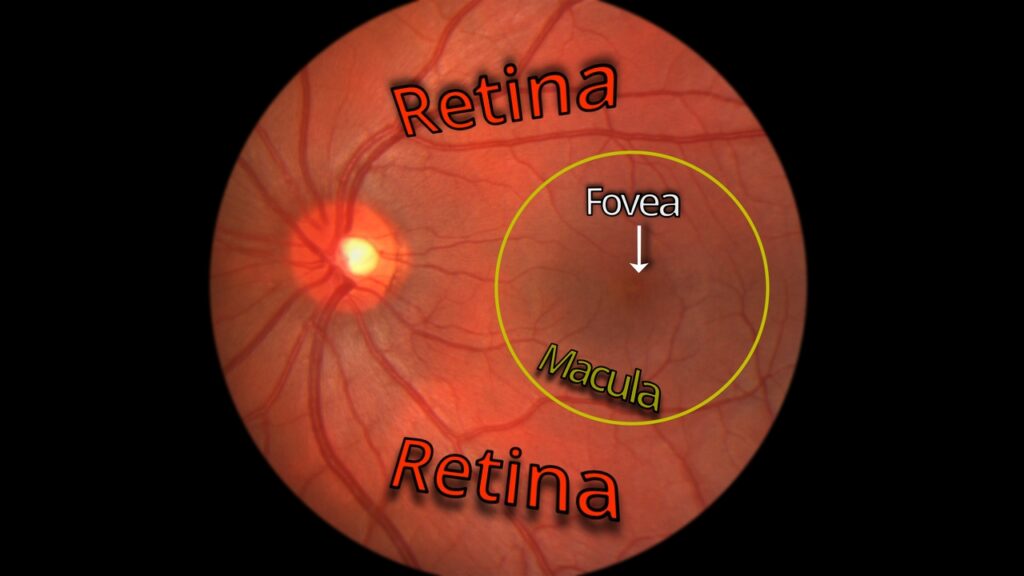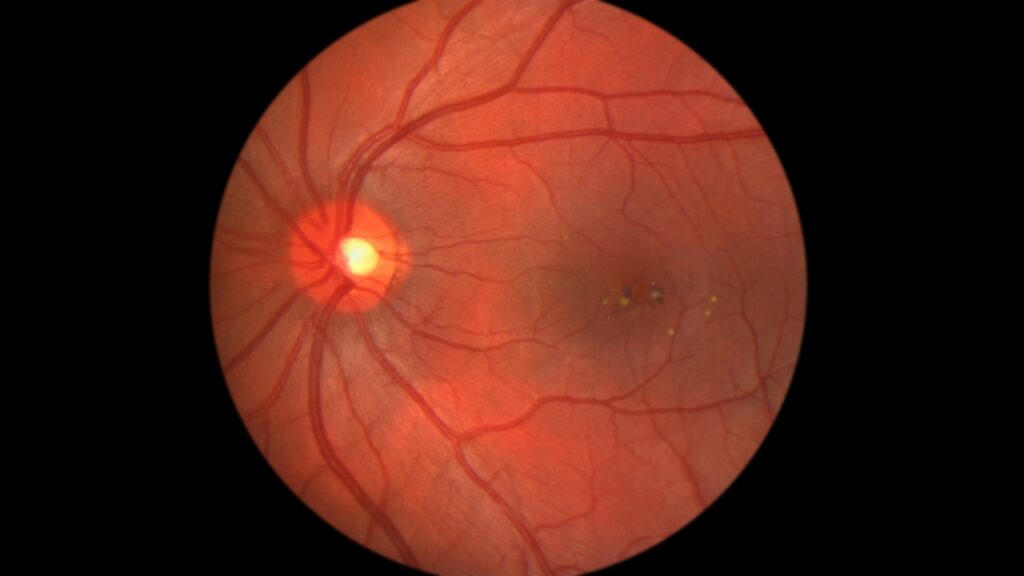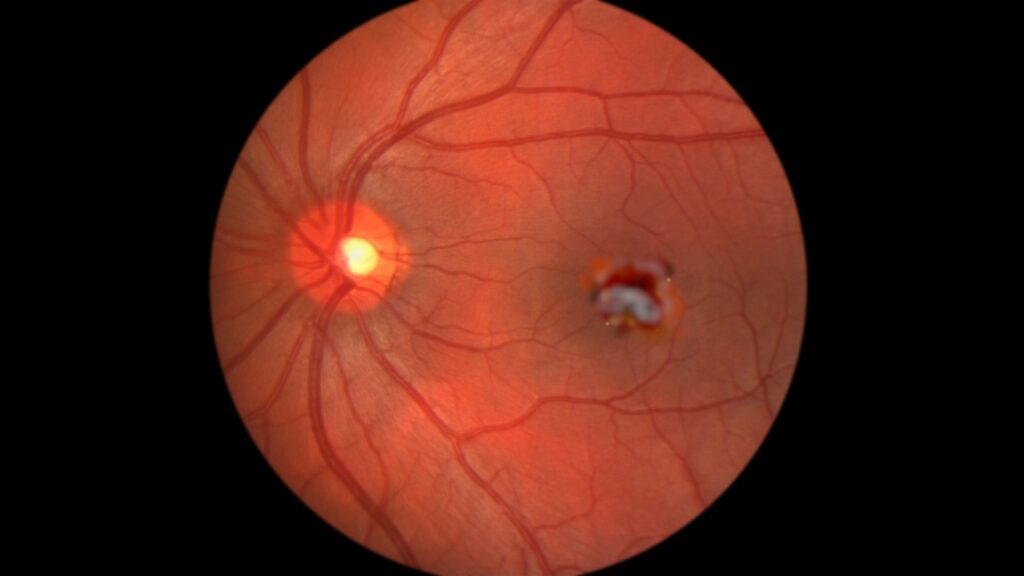Macular Degeneration

Demonstration of a Healthy Macula
What is macular degeneration?
The most important part of our retina (our sight sensory cells in the back of our eyes) is the fovea, which is the epicenter of the macula. The macula, therefore, is where our most fine-tuned central vision cells reside. Macular degeneration is a progressive disease that affects the macula. This condition causes a loss of vision in the center of the visual field, making it difficult to read, drive, recognize faces, or perform other daily tasks that require detailed vision. Symptoms of macular degeneration include blurred or distorted vision, difficulty reading, and a gradual loss of central vision. The effects on vision can range from mild to severe, ultimately leading to legal blindness in some cases.
The risk factors for progression of macular degeneration include aging, genetics, smoking, and certain medical conditions such as cardiovascular disease and obesity. Macular degeneration is the leading cause of vision loss in people over the age of 50 in the US, with an estimated 11 million Americans affected by the disease. Since it is associated with age, it is often referred to as age-related macular degeneration (abbreviated as ARMD or AMD)
The key anatomical components of the eye affected by macular degeneration include the macula and its central point called the fovea, but the area of the retina surrounding the macula may also be involved. There are two types of macular degeneration: Nonexudative (dry AMD), which is the most common and causes gradual vision loss, and Exudative (wet AMD), which is less common but more severe because it can cause rapid and severe vision loss. Dry AMD may include drusen (yellow deposits growths below the sensory cells) growth which leads to degeneration in the macula, while wet AMD is often the continuation of dry AMD characterized by a breakthrough growth of abnormal blood vessels through the retina. Early detection and treatment are crucial in managing the symptoms and effects of macular degeneration.
What are the different types of Macular Degeneration?
Macular degeneration is a common eye condition that affects the macula, which is responsible for fine tuned central vision. There are two main types of macular degeneration: dry and wet. Dry macular degeneration is characterized by the gradual breakdown of light-sensitive cells in the macula, resulting in a gradual loss of central vision. On the other hand, wet macular degeneration is often the resultant continuation of dry degeneration which involves added the growth of abnormal blood vessels underneath the macula, which can leak blood and fluid, leading to rapid and severe central vision loss. Understanding the differences between these two types of macular degeneration is essential for early detection and management of this progressive eye disease. Let’s talk about each form separately…
What is Dry (Non-Exudative) Macular Degeneration?

demonstration of Dry AMD (not bleeding, “dry”)
Dry AMD, also known as dry age-related macular degeneration (dry ARMD) or non-exudative AMD, is a common eye condition that may cause vision loss in people, especially over the age of 50. For those diagnosed with the dry form of AMD, there are several treatments and recommendations for managing the condition.
Lifestyle changes such as quitting smoking, improving diet, and exercising regularly can help slow down the progression of dry AMD. Medications such as anti-angiogenic drugs may be prescribed to prevent the growth of abnormal blood vessels in the eye. Nutritional supplements such as vitamins C and E, zinc, and lutein have also been found to help with managing dry AMD. Vitamins that have the AREDS-2 (Age Related Eye Disease Study – 2nd) formulations are often suggested by eye care professionals.
Regular eye tests are crucial for monitoring the progression of macular degeneration, and consulting with an optometrist or ophthalmologist is important for determining the best course of action for individual cases. An eye doctor can provide personalized treatment plans and recommendations based on the severity of the condition.
What is Wet (Exudative) Macular Degeneration?

demonstration of Wet AMD (bleeding, “wet”)
Wet macular degeneration, also known as wet age-related macular degeneration (wet ARMD) or exudative AMD, is a chronic eye condition that affects the macula, the central part of the retina responsible for sharp, central vision. Wet macular degeneration, is also known as neovascular AMD and is considered the more severe form of the disease because its associated leaking vessels can affect vision so rapidly, and often results as the progression of dry AMD.
Symptoms of wet macular degenration can include sudden loss or distortion of central vision, straight lines appearing wavy, and the presence of a blind spot in the central vision. Diagnosing Wet AMD often involves the use of optical coherence tomography (OCT) and fluorescein angiography. OCT is a non-invasive light imaging test that provides high-resolution cross-sectional images of the retina, while fluorescein angiography involves the use of a special dye and a camera to take pictures of the blood vessels in the eye.
Wet macular degeneration can lead to rapid and severe damage to vision due to the presence of abnormal blood vessels that leak fluid and blood under and into the retina. Treatment options for Wet AMD include injections to address the abnormal blood vessels and reduce leakage. These treatments aim to slow down the progression of the disease and prevent further vision loss.
Causes and Risk Factors
Is age associated with macular degeneration?
Yes. That is why it is referred to as AGE-RELATED macular degeneration. It is definitely more observed in the aged eye. Age-related factors that contribute to the development of age-related macular degeneration (AMD) include an increased risk for those over 75, the association with being 50 and older, and the higher likelihood for women (due to their longer lifespan). As individuals age, the cells in the macula, responsible for central vision, become more vulnerable to damage and degeneration due to natural progressions that occur within the retina.
The wear and tear on the macula that occurs naturally over time cannot be reversed, but lifestyle modifications such as maintaining a healthy diet rich in antioxidants, not smoking, and protecting the eyes from UV radiation can help mitigate the risk of developing AMD. Regular eye examinations and prompt treatment can also help manage the condition.
Are their Genetic factors associated with Macular Degeneration?
Yes. Genetic factors play a significant role in both age-related macular degeneration (AMD). In AMD, genetic variations in several genes, including HTRA1 and ARMS2, have been linked to an increased risk of developing the condition. This means that a person’s family history plays a crucial role in the development of macular degeneration. In fact, having a first-degree relative with AMD can increase an individual’s risk by two to three times. Understanding the genetic factors and specific genes associated can therefore help identify individuals at higher risk and potentially lead to the development of targeted treatments or preventive measures.
Which Environmental factors play a role in Macular Degeneration?
Macular degeneration is influenced by various environmental factors, including UV light exposure, smoking, poor nutrition, and lack of exercise. Prolonged exposure to UV light can damage the macula, leading to the development or progression of the disease. Smoking has been linked to an increased risk of macular degeneration, as it can constrict blood vessels and lead to oxidative damage in the retina. Poor nutrition, particularly a diet lacking in antioxidants, vitamins, and minerals, can also contribute to the development of the disease. Sedentary lifestyle with lack of exercise also yields an increase the risk of macular degeneration.
To mitigate environmental risks, individuals can do such things as to wear UV-blocking sunglasses to protect their eyes from harmful UV rays and quit smoking. Maintaining a healthy diet rich in leafy greens, fish, and other foods high in antioxidants can support eye health. A natural diet is not likely able to supply the suggested amount of vitamins, so supplements that include the AREDS-2 formulation are a good idea. Incorporating regular exercise into daily routines can also help improve blood circulation and overall eye function.
What are the Symptoms associated with Macular Degeneration?
Blurred vision
Age-related macular degeneration (AMD) is a common eye condition that can cause blurred vision. This occurs when the macula, located in the center of the retina, deteriorates, leading to the loss of central vision. In the early stages of AMD, the vision may only be slightly blurred, but as the condition progresses, and the center of the macula, the fovea, becomes involved, vision can become significantly impaired. Exudative AMD has a greater risk of causing a sudden and severe loss of central vision since blood can leak and spread more rapidly, while nonexudative AMD typically progresses more slowly, since it is associated with slow druses growth which cause a slow degeneration of the retinal tissue in the location that it is growing.
Again, to maintain clear vision, it is essential to have regular eye exams and monitor any changes in vision. Quitting smoking, eating a healthy diet, and protecting the eyes from UV light may also help slow down the progression of the dry form of AMD, but in cases where vessels grow and leak, treatments such as anti-VEGF injections or laser therapy may also be necessary to slow the progression of the disease and preserve vision.
Blind spots in central vision
Blind spots can significantly impact daily activities and overall quality of life. Individuals may experience difficulty reading, recognizing faces, and performing tasks that require sharp, central vision.
Potential treatments and management strategies for blind spots in central vision include vision rehabilitation, which involves using techniques to maximize the use of remaining vision, and assistive technology such as magnifiers, screen readers, and talking devices. Other strategies include making modifications to the home environment to reduce the impact of the blind spots and improve safety.
Technology is moving forward quickly, and new products may be available today that were not available yesterday. So, even if your doctor is not aware of low vision devices that may help, a deeper research into new available technology may prove beneficial.
How can macular degeneration impact lifestyle?
Loss of central vision
Loss of central vision severely impacts everyday tasks and activities. Reading becomes difficult, as the ability to see and focus on the words is impaired. Driving also becomes unsafe, as central vision loss affects the ability to see details in front and to the sides. Driving privileges are often lost due to disease progression. Even recognizing faces becomes challenging, leading to social isolation and communication difficulties.
The impact of central vision loss on independence and quality of life can be significant. Individuals may struggle with maintaining their daily routines, leading to a loss of confidence and a decrease in overall well-being. This often leads to the need for low vision devices, such as magnifiers or telescopes, and vision rehab services to learn how to use these devices effectively.
Coping strategies and adaptive techniques for living with central vision loss include utilizing contrast and lighting, using magnification and text-to-speech technology, and modifying the environment for easier navigation. Seeking support from low vision specialists and support groups can also be helpful in adjusting to the challenges of central vision loss.
Overall, central vision loss associated with macular degeneration may have a profound impact on daily life, but with the right support and tools and understanding, individuals can learn to adapt and maintain their independence and quality of life.
Need Consistanly Cheap Contacts?
DeliverContacts.com always guarantees you are paying low prices, every time you buy. We will never play games with our pricing or take part in manipulative discounts. Just consistently cheap contacts, forever.
Give your box a search below and see for yourself! 100% Free shipping and returns on all products!
